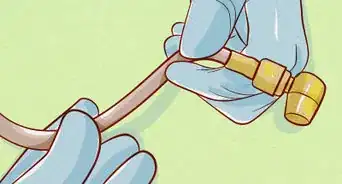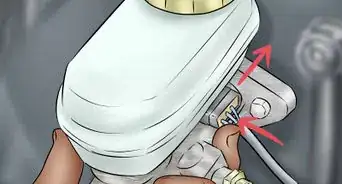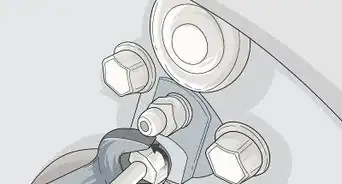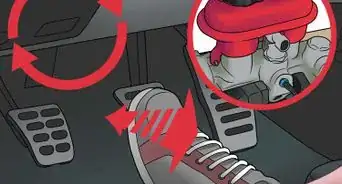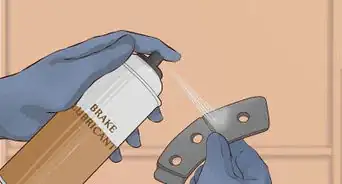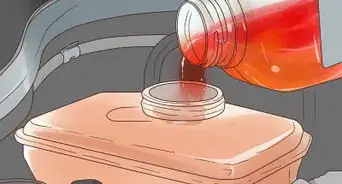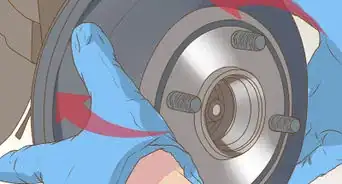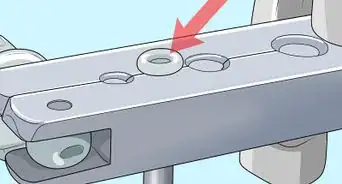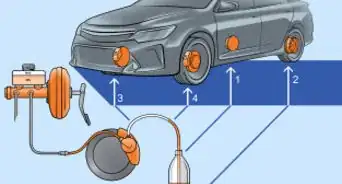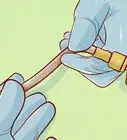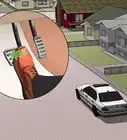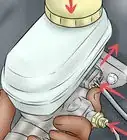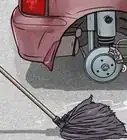This article was co-authored by Duston Maynes. Duston Maynes is an Automotive Repair Specialist at RepairSmith. Duston specializes in leading a team that handles a variety of automotive repairs including replacing spark plugs, front and rear brake pads, fuel pumps, car batteries, alternators, timing belts, and starter motors. Duston holds an Associate’s degree in Automotive/Diesel Technology from The Universal Technical Institute of Arizona and is a Certified Diagnostic Technician and Automobile Mechanics Technician through BMW STEP. RepairSmith received The 2020 Big Innovation Award by Business Intelligence Group and The Startup of the Year by the American Business Awards. RepairSmith was also included in Built in LA’s 50 Startups to Watch and The Business Intelligence Group’s 52 Names Leading the Way in Customer Service. RepairSmith offers in-home services to provide car owners convenient and complete auto repair everywhere.
wikiHow marks an article as reader-approved once it receives enough positive feedback. In this case, 87% of readers who voted found the article helpful, earning it our reader-approved status.
This article has been viewed 616,447 times.
Changing your brake pads is a much cheaper option than taking it to a car shop, which can usually lead to an expensive fee for anyone. For the cost of materials, you'll be able to get your car stopping properly after following these steps.
Steps
Exposing the Brake Pads
-
1Get the correct brake pads. Pads are available at any auto parts store or your local car dealership. Just let them know the year, make and model of your car and select a pad in your price range. In general, the more expensive they are, the longer they last.
- Some very expensive pads with a higher-than-desirable metal content may be aimed at the 'Rally' market for use with performance Rotors. You'll probably want to avoid these because they are likely to cause premature wear of standard Rotors. Also, some people find that less expensive pads are noisier than "brand name" pads.
-
2Make sure the vehicle is cooled down. If you have recently driven, you may be working with extremely hot pads, calipers and rotors. Be sure that these parts are safe to touch before moving on.Advertisement
-
3Loosen the lug nuts. Using the lug wrench provided along with the car's jack, loosen each of the lug nuts that hold the wheels onto the car about two thirds of the way.
- Don't loosen all the tires at once. Generally, you'll change at least the two front pads or the two back pads, depending on your car and how evenly the brakes wear. So either start with the front or the back.
-
4Carefully jack the car up until it can be removed comfortably. Consult your owner's manual to determine the correct position for the car jack under your car. Put some blocks behind the other wheels to stop the car from rolling forward or back.
- Place a jack stand under the frame of the vehicle. Do NOT trust the jack alone. Repeat for the other side of the car so that both sides are securely supported.
-
5Remove the wheels. Finish loosening and removing the lug nuts when the car is raised. Pull the wheel straight out towards you to remove it.
- If the wheel rims are alloy and on the studs, you should clean the studs, stud holes, rotor mounting surface, and the rear mounting surface of the alloy wheel with a wire brush and apply anti seize compound before refitting the wheel.
-
6Remove the caliper bolts using the correct size of socket or ring-spanner.[1] The caliper fits over the brake rotor like a clamp and its job is to slow the wheel using hydraulic pressure. The brake pads will create friction with the rotors to slow the vehicle to a stop. Calipers generally come in one-piece or two-piece designs, secured with between two and four bolts at the inside of the stub axle housing, where the tire fits onto the axle. Spray these bolts with WD-40 or PB Penetrating Catalyst to aid in removing them.
- Check the caliper pressure. The caliper of a car at rest should move back and forth a little bit. If not, the caliper is under pressure and it may fly off when you remove the bolts. Take extra precaution when checking to keep your body to the side of its path, even if it is loose.
- Check to see if there are any shims or performance washers fitted between the caliper mounting bolts and the mounting surface. If there are, remove them and keep track of them to replace later. You will need to refit the caliper without the brake pads and measure the distance from the mounting surface to the brake pad to replace them appropriately.
- Many Japanese vehicles use a two-piece sliding caliper that only requires the removal of two forward-facing slider bolts, with 12-14mm heads. You will not need to remove the entire caliper.
-
7Carefully hang the caliper with a small piece of wire to the wheel well. The caliper will still be connected to the brake line, so hang it up with a small piece of wire hanger or other scrap metal, so that it won't hang and put pressure on the flexible brake hose.
Changing the Pads
-
1Remove the old pads. Finally! Note how each brake pad is attached. They typically snap or clip in with attached metal clips. Remove both pads. They may take a little force to pop out, so take care not to damage the caliper or brake line while getting them out.
- Inspect brake rotors for warped, heat damage or cracks to surface and replace as needed. Rotors are recommended to be replaced or resurfaced during brake pad replacements.
-
2Put the new pads on. At this point, you can spread anti-seize lubricant on the metal contact edges and on the back of the pads. This will prevent a lot of squeaking. However, do not get any lubricant onto the inside of the brake pads. If any lubricant touches that material, the brake will not provide friction, and will be useless. Attach the new pads exactly the way the old ones were attached.
-
3Check the brake fluid. Check your vehicle's brake fluid level and add some if necessary. Replace the brake fluid reservoir cap when finished.
-
4Replace the caliper. Slide the caliper slowly back over the rotor, proceeding easily so as not to damage anything. Replace and tighten the bolts that hold the caliper in place.
-
5Put the wheel back on. Slide the wheel back into place and hand tighten each of the lug nuts snug before lowering the car.
-
6Tighten the lug nuts. When the car is back on the ground, tighten the lug nuts in a "star" pattern. Tighten one lug nut, then one across from it until each nut is fully tightened to torque specification.
- Check the owner's manual to find the torque specifications for your vehicle. This will ensure the lugs have been tightened enough to prevent the wheel coming off or over-tightening.
-
7Start the vehicle. Making sure the vehicle is in neutral or park, pump the brakes 15 to 20 times to make sure the pad is seated properly. Top off brake fluid levels or follow bleeding of brakes section to flush out old fluid and replace with new fluid.
-
8Test your new brake pads. Going no more than 5 mph (8.0 km/h) on a quiet residential street, brake like normal. If the vehicle seems to stopping normally, repeat the test and go up to 10 mph (16 km/h). Repeat several more times, gradually going up to 35 or 40 mph (56 or 64 km/h). Also check in reverse. These braking tests ensure there are no issues with your brake-pad installation, gives you confidence when driving on main streets and helps "seat" the brake pads into place.
- Listen for problems. The new pads may squeak a bit, but i you should hear a grinding, metal-on-metal sound, you probably have the brake pads reversed (i.e., the inside surface is incorrectly facing out). This should be corrected immediately.
Bleeding the Brakes
-
1Remove the cap from the brake master cylinder.[2] Brake fluid will become contaminated with dirt and other particulate from the air and the mechanics of the car. It will also absorb moisture from the air, dangerously lowering its boiling point. You'll need to bleed the brake fluid from the system before changing your pads and calipers, but you'll also (counterintuitively, perhaps) want to make sure the fluid is topped off before you do this. Check the fill line and add a little if you need to. Leave the cap off while you bleed the system.
- The reason you need to add fluid is that you're bleeding the fluid from the calipers themselves--the fluid trapped in the line--and you still need a steady supply in the master cylinder.
-
2Determine the sequence of the bleed. Generally, you want to bleed the brake most distant from the master cylinder first, so you'll need to check the owner's manual before you do this. All cars differ in the particular order. If you don't have the owner's manual, check with an auto parts store.
-
3Fit a small plastic hose to the bleeder nipple. Cheap aquarium tubes work well for this. Place the other end of the hose in a small bottle or pan to catch the fluid. To keep air from flowing back into the system, you should hang or hold the bottle above the calipers and keep gravity on your side.[3]
-
4Have an assistant pump the brakes. With the engine off, have your friend continually pump the brakes until they experience resistance. They should shout to you to let you know they're feeling resistance, at which point you should unscrew the bleeder screw slightly and tell them to hold the brake down.
- The fluid should drain down the hose into the bottle or pan at this point. Screw the bleeder screw back in when your friend's foot touches the floor.
- Repeat this process until you see no air bubbles in the tube.[4]
-
5Double check the system for air bubbles. If compressing the brake pedal results in the fluid gurgling in the master cylinder, there are still air bubbles in the system. Start bleeding them again before you continue.
Expert Q&A
-
QuestionHow do I know if my brake pads are worn out?
 Duston MaynesDuston Maynes is an Automotive Repair Specialist at RepairSmith. Duston specializes in leading a team that handles a variety of automotive repairs including replacing spark plugs, front and rear brake pads, fuel pumps, car batteries, alternators, timing belts, and starter motors. Duston holds an Associate’s degree in Automotive/Diesel Technology from The Universal Technical Institute of Arizona and is a Certified Diagnostic Technician and Automobile Mechanics Technician through BMW STEP. RepairSmith received The 2020 Big Innovation Award by Business Intelligence Group and The Startup of the Year by the American Business Awards. RepairSmith was also included in Built in LA’s 50 Startups to Watch and The Business Intelligence Group’s 52 Names Leading the Way in Customer Service. RepairSmith offers in-home services to provide car owners convenient and complete auto repair everywhere.
Duston MaynesDuston Maynes is an Automotive Repair Specialist at RepairSmith. Duston specializes in leading a team that handles a variety of automotive repairs including replacing spark plugs, front and rear brake pads, fuel pumps, car batteries, alternators, timing belts, and starter motors. Duston holds an Associate’s degree in Automotive/Diesel Technology from The Universal Technical Institute of Arizona and is a Certified Diagnostic Technician and Automobile Mechanics Technician through BMW STEP. RepairSmith received The 2020 Big Innovation Award by Business Intelligence Group and The Startup of the Year by the American Business Awards. RepairSmith was also included in Built in LA’s 50 Startups to Watch and The Business Intelligence Group’s 52 Names Leading the Way in Customer Service. RepairSmith offers in-home services to provide car owners convenient and complete auto repair everywhere.
Automotive Repair Specialist If the pads get too low, then you'll start feeling a grinding and need a replacement. Some models have a little metal clip on the side of the brake pad, and when the pad material gets down to a certain level, the clip will start making contact onto the rotor, making a high pitched squeal.
If the pads get too low, then you'll start feeling a grinding and need a replacement. Some models have a little metal clip on the side of the brake pad, and when the pad material gets down to a certain level, the clip will start making contact onto the rotor, making a high pitched squeal.
Warnings
- Always use jack stands and use supports behind the wheels to avoid rolling. Do not trust a jack by itself.⧼thumbs_response⧽
- Do not let lubricant touch the brake pad material. If it does, the brake provides no friction, and is useless.⧼thumbs_response⧽
- Do not remove the brake line from the caliper this will cause air to enter the lines and make a mess of things.⧼thumbs_response⧽
References
- ↑ http://www.stoptech.com/technical-support/technical-white-papers/brake-system-and-upgrade-selection
- ↑ http://www.caranddriver.com/features/how-to-bleed-your-brakes-feature
- ↑ http://www.popularmechanics.com/cars/how-to/maintenance/4213448
- ↑ http://www.caranddriver.com/features/how-to-bleed-your-brakes-feature
About This Article
Before you change the brake pads in your car, make sure it has had time to cool down so the brakes aren’t hot. Then, remove the wheel and the caliper to reveal the brake pads. Snap off the old brake pads and insert the new ones in the same position. If you want, you can spread anti-seize lubricant on the metal contact edges and on the back of the pads to prevent squeaking. Just don’t put lubricant inside the brakes or they won’t work. Keep reading for advice from our Mechanic reviewer on bleeding the brakes and filling the brake reservoir.

